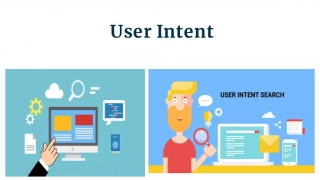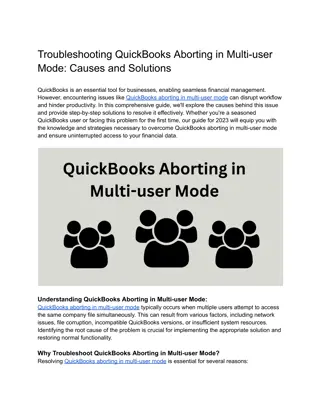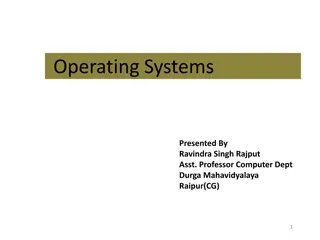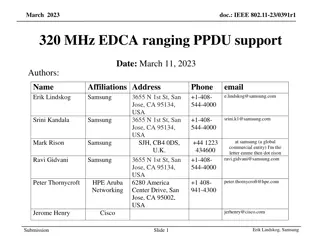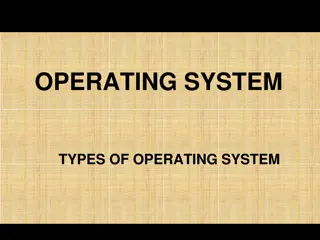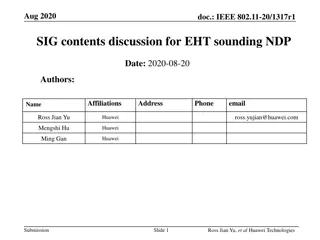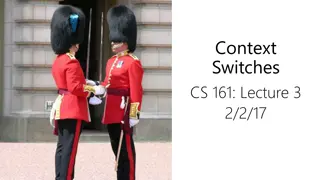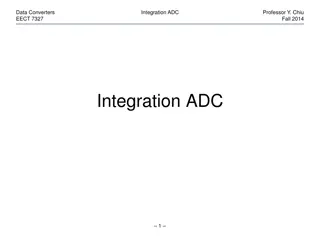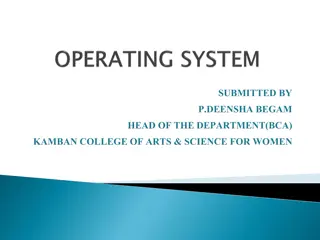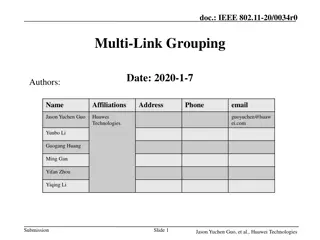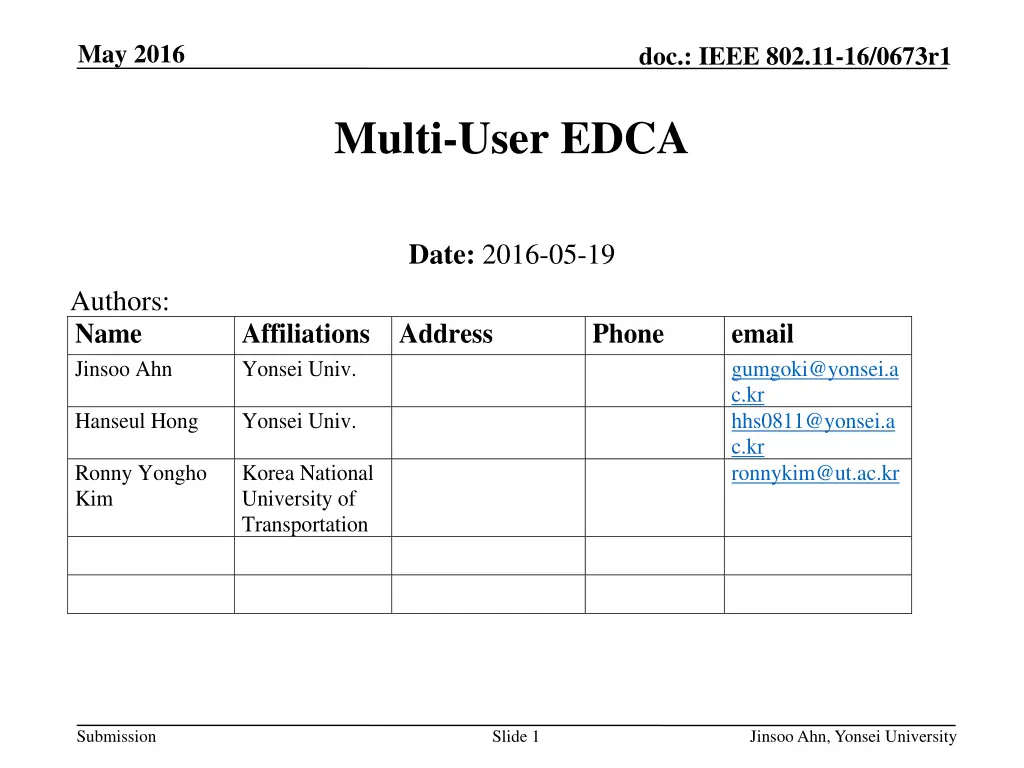
IEEE 802.11-16/0673r1 Multi-User EDCA - May 2016 Document Insights
Delve into the key concepts of IEEE 802.11-16/0673r1 Multi-User EDCA as discussed in the May 2016 document. Explore topics such as MU-MIMO procedures, channel access schemes, virtual queues for UL MU transmission, trigger frame ambiguities, and more, presented by Jinsoo Ahn from Yonsei University.
Download Presentation

Please find below an Image/Link to download the presentation.
The content on the website is provided AS IS for your information and personal use only. It may not be sold, licensed, or shared on other websites without obtaining consent from the author. If you encounter any issues during the download, it is possible that the publisher has removed the file from their server.
You are allowed to download the files provided on this website for personal or commercial use, subject to the condition that they are used lawfully. All files are the property of their respective owners.
The content on the website is provided AS IS for your information and personal use only. It may not be sold, licensed, or shared on other websites without obtaining consent from the author.
E N D
Presentation Transcript
May 2016 doc.: IEEE 802.11-16/0673r1 Multi-User EDCA Date: 2016-05-19 Authors: Name Jinsoo Ahn Affiliations Address Yonsei Univ. Phone email gumgoki@yonsei.a c.kr hhs0811@yonsei.a c.kr ronnykim@ut.ac.kr Hanseul Hong Yonsei Univ. Ronny Yongho Kim Korea National University of Transportation Submission Slide 1 JinsooAhn, Yonsei University
May 2016 doc.: IEEE 802.11-16/0673r1 Introduction MU DL is defined for MU-MIMO procedure in 11ac[1] Sharing a TXOP is a channel access scheme for MU-MIMO Channel Access follows the rules for the Access Category of Primary Access Category Transmission success is judged by Primary transmission only 802.11ax MU UL channel access has not been defined yet Many comments are related to Access Category and channel access of UL MU transmission[2] CID 158, 799, 809, 814, 815, 816, 1646, 2173, 2271, 2638, 2644, 2656 In this contribution, virtual queue for UL MU transmission to remove the ambiguities regarding UL MU is discussed. Submission Slide 2 JinsooAhn, Yonsei University
May 2016 doc.: IEEE 802.11-16/0673r1 Review DL MU-MIMO transmission[1] AC_VO AC_VI AC_BE AC_BK AP STA 1 DL PPDU BAR BAR AIFS STA 2 DL PPDU STA 3 DL PPDU Backoff AIFS[BE] CW[BE] Backoff AIFS[BK] CW[BK] BA1 BA2 BA3 Backoff AIFS[VO] CW[VO] Backoff AIFS[VI] CW[VI] STAs Virtual Contention [Choose Primary AC] EDCA parameters follow Primary AC TXOP Initiator = TX Data Multiple AC could exist on DL Data Choose Primary AC by virtual contention DL OFDMA may reuse this scheme[3] Submission Slide 3 JinsooAhn, Yonsei University
May 2016 doc.: IEEE 802.11-16/0673r1 Channel Access for Trigger Frame Ambiguity 1 When or How often Trigger Frames should be transmitted? AP AIFS Trigger Frame M-BA STA 1 UL PPDU STA 2 UL PPDU STA 3 UL PPDU STAs Ambiguity 2 Which EDCA parameters should Trigger Frame follow ? MU UL begins with Trigger Frame transmitted by AP Need to define a procedure whether to transmit DL data or to transmit Trigger Frame Hard to know which EDCA parameters are appropriate for UL transmission Submission Slide 4 JinsooAhn, Yonsei University
May 2016 doc.: IEEE 802.11-16/0673r1 Channel Access for Trigger Frame Buffer Status Report (BSR) Procedure was adopted for 802.11ax MU UL and it should be used for AP to determine UL transmission scheduling DL transmission or UL transmission UL Trigger Frame transmission timing Although Buffer Status Report Procedure is defined, Access Category or TID of UL data can not be regulated for MU UL transmission Trigger Frame can not restrict transmission of any AC or TID of STAs Therefore, applying legacy access category scheme including sharing a TXOP scheme for Trigger Frame Channel Access is not feasible Submission Slide 5 JinsooAhn, Yonsei University
May 2016 doc.: IEEE 802.11-16/0673r1 UL MU access category for Trigger Frame (BSR Info) (BSR Info) MU_UL MU_UL Threshold_k Threshold_k Virtual Queue Virtual Queue Additional BSR Info After threshold crossing, initializes minBO and CW value New BO BO UL MU Access Category and UL MU virtual queue can clarify the two ambiguities of UL MU channel Access When or how often Trigger Frames should be transmitted ? Which EDCA parameters should Trigger Frame follow ? Queue size of AC_MU is determined with cumulated Buffer Status Report information and STAs SU transmission status Submission Slide 6 JinsooAhn, Yonsei University
May 2016 doc.: IEEE 802.11-16/0673r1 UL MU access category for Trigger Frame (MSDU, UP) For internal contention, UL MU virtual contention parameters controlled by virtual queue size Large virtual queue size should provide a high probability of channel access small Backoff (BO) value If AC_MU wins the internal contention, trigger frame follows the channel access parameters of AC_MU (BSR Info) AC_VO AC_VI AC_VI STA 3 AC_BE AC_BK AC_MU AC_VO STA 5 AC_BE STA 3 AC_VO STA 4 AC_VI STA 1 AC_MU (Virtual) AC_BE STA 2 AC_VO STA 2 Submission Slide 7 JinsooAhn, Yonsei University
May 2016 doc.: IEEE 802.11-16/0673r1 UL MU access category for Trigger Frame (MSDU, UP) (MSDU, UP) (BSR Info) (BSR Info) AC_VO AC_VI AC_VI STA 3 AC_BE AC_BK AC_MU AC_VO AC_VI AC_VI STA 3 AC_BE AC_BK AC_MU AC_VO STA 5 AC_VO STA 5 AC_BE STA 3 AC_BE STA 3 AC_VO STA 4 AC_VO STA 4 Long queue AC_VI STA 1 AC_VI STA 1 AC_BE STA 2 AC_BE STA 2 AC_VO STA 2 AC_VO STA 2 Short queue Large BO Small BO 4 1 24 15 31 4 1 24 15 0 AC_VO DL PPDU Trigger Frame (DL MU based on TXOP sharing possible) Backoff (BO) values should be controlled depending on the AC_MU queue size BO values should be controlled with Contention Window (CW) size Unlike the conventional BO, minimum(Min) BO should be regulated to solicit large number of STAs. Submission Slide 8 JinsooAhn, Yonsei University
May 2016 doc.: IEEE 802.11-16/0673r1 Example of UL MU Contention Control Category Queue Length(Q) Q<Th_1 Min BO CW(Max BO) 1 (Hold BO) 2 3 4 1024 (Hold) 8 0 1024 (Hold) 31 31 Th_1 Q<Th_2 Th_2 Q<Th_3 0 0 N+1 (N 1) Th_n Q AC_MU gets virtual back-off values in the range of [Min BO, CW] instead of [0,CW] If the queue length of AC_MU(UL) is smaller than certain threshold value, trigger frame cannot get a transmission opportunity due to its large minimum back off number Either fixed CW or variable CW can be used N>1 : variable CW N=1 : fixed CW with UL MU threshold Submission Slide 9 JinsooAhn, Yonsei University
May 2016 doc.: IEEE 802.11-16/0673r1 Channel Access for Trigger Frame BO=[MinBO, CW] AP Trigger Frame M-BA AIFS(AC_MU) STA 1 UL PPDU STA 2 UL PPDU STA 3 UL PPDU STAs TXOP(AC_MU) When AC_MU wins the virtual contention, Trigger frame is transmitted with Trigger frame access category (AC_MU) EDCA parameters EDCA parameters for Trigger frame access category (AC_MU) needs to be defined Not only fixed value, but also variable value which is based on queue length could be considered (Legacy ACs could be reused for AC_MU, e.g., AC_VI) Submission Slide 10 JinsooAhn, Yonsei University
May 2016 doc.: IEEE 802.11-16/0673r1 Revisit: DL MU channel access procedure We could have two options of DL MU Opt.1 : Using sharing a TXOP method for both DL-MU MIMO and DL-MU-OFDMA Opt.2 : Using virtual DL_MU queue similar to virtual UL_MU queue Opt.1 is simple but it has some regulations Since the failure of Primary transmission is regarded as the transmission failure, an inefficient procedure should be taken, i.e., CW should be doubled Multi-TID cannot be used for Primary transmission Opt.2 requires new procedure but it could be more flexible Transmission success can be more properly defined (e.g. Only one response of DL MU transmission can be considered as a success) Multi-TID A-MPDU could be utilized for DL MU as well Submission Slide 11 JinsooAhn, Yonsei University
May 2016 doc.: IEEE 802.11-16/0673r1 Further Discussion on MU Channel Access We need more discussion whether sharing a TXOP is efficient and only option for DL MU channel access. Specific parameters for contention need to be defined. Min BO, Max BO(=CW), TXOP, AIFSN Whether parameters are variable or fixed If other Trigger variant frames need to be transmitted with contention based channel access, Trigger variant frames channel access methods need to be defined. MU-RTS may follow EDCA of the following channel access procedure of MU data transmission. UL MU for management frames including BSR procedure may use different mechanism and UL MU parameters. Submission Slide 12 JinsooAhn, Yonsei University
May 2016 doc.: IEEE 802.11-16/0673r1 Conclusion MU UL virtual queue based on BSR information could be a solution for 11ax EDCA Variable virtual contention parameters for AC_MU could control when and how often Trigger frames are transmitted Although BSR procedure is considered for UL MU transmission, actual UL PPDU could be a Multi-TID A- MPDU and its Access Category is hard to known to AP AP cannot determine which access category shall be adopted for channel access parameters Regardless of UL PPDU contents, Trigger frame always need to be transmitted following AC_MU Submission Slide 13 JinsooAhn, Yonsei University
May 2016 doc.: IEEE 802.11-16/0673r1 StrawPoll 1 Do you agree to add to the TG Specification Frame work document? x.y.z. Spec shall define a virtual queue which is based on BSR(Buffer Status Report) information for trigger frame channel access procedure Y N A Submission Slide 14 JinsooAhn, Yonsei University
May 2016 doc.: IEEE 802.11-16/0673r1 References [1] Draft P802.11REVmc_D5.0 [2] 11-16/0535r03 Comments on TGax D0.1 [3] 11-15/0132r16 Spec Framework Submission Slide 15 JinsooAhn, Yonsei University

